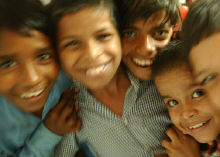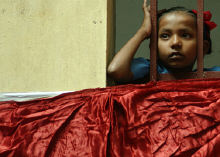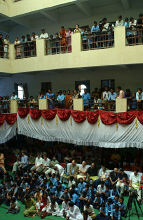Prayas
India
After four rottenly humid, dirty, exhausting days in Delhi, I tossed my towel of compassion in the toilet – or side of the road, as is commonly used there.
The barefoot, half-clothed children who wandered up to me with one hand on my arm and the other curled toward their mouths in the universal symbol of “food,” were ignored, left to find a tourist untainted by the buy-a-piece-of-food-for-one-child- have-thirteen-cricket-teams-of-children- following-you-the-rest-of-the-day concept. “Ma’am,” yelled the men and women from their homes, a few square feet of sidewalk, the word following my back as it got lost in the crowd, never quite reaching my ears.
I was looking at another 15 days in India, and I’d already grown jaded and cynical, the sharp edges of the horrors of extreme poverty already dulled in my mind. Not even a leper could squeeze an ounce of sympathy (or a rupee) from my broke and jet-lagged ass.
Spending 19 days following an American military band around India as their photographer seemed cake compared to my usual travels. Instead of being on a severely uncomfortable, yet amazingly affordable, bunk bed with the sounds of many snorers filling the room, I was staying in peaceful, clean and comfortable hotel rooms. I was finally not a budget traveler.
Yet instead of surrounding myself with the culture, at the end of the day, I’d shrink into the comfort of my hotel bed, far away from the reality of the city, thankful to finally clear my head of the noise of the city – the horns, the engines, and the people.
On the fifth day, I awoke with the band, and we all piled into starchy white embassy vans to ship us to the children’s home. For about an hour, the horns honked, the vans swerved, and hundreds of accidents were narrowly missed, and then we turned right down a street. The street came alive with women, dressed in vibrant saris, pouring through trash for scraps of food to eat. Children stood near their mothers, while a man pissed on a wall. The only building of any significant height was Prayas Children’s Home.
When the vans pulled up to the large, white square cement building, we heard the sounds of a drum. The van door opened, and the loud drum echoed from the empty entrance way to the children’s home. We were whisked into the entranceway, where two young boys greeted us and anointed our foreheads with the traditional red tikka, a dusty pigment. The drummer was behind them, drumming himself in circles, with a young man in traditional costume dancing.


Prayas Boys
![]()
![]()
![]()
As the band walked in, I faced the entrance outward, having been poised to take photographs of their entrance, and as I turned around the young man dancing grabbed my hand and spun me around. The rest of the group had walked by without notice, but perhaps as the last chance, he dragged me into his dance.
My disgust at the begging and the hopelessness and the stares by creepy men throughout the whole week flew away in grains, like the loose tikka on my forehead, as we spun in circles together, my one hand on my camera, his one hand on his costume, and our others joined in our impromptu clash of culture.
When he finally dropped my hand and returned to his solo run, I turned to see my gigantic smile reflected in the faces of the band. They, too, had lost their pent-up frustration from the single act of joy from an innocent young boy.


Prayas Girl
![]()
![]()
![]() We spent the day at Prayas, which we learned housed 450 boys who were taken off the streets and saved from exploitation and abuse, part of the 50,000 children Prayas takes care of in three of India’s states. Most of these children were between five and 18 years old. Some had AIDS, some had other STDs from their previous lives in the sex industry or simply from being raped. Some were shy and reserved, and some were bold and curious. The home had also invited some of the young girls from another local home to Prayas for the concert, and before the band began, the girls and boys each performed a traditional dance and a song.
We spent the day at Prayas, which we learned housed 450 boys who were taken off the streets and saved from exploitation and abuse, part of the 50,000 children Prayas takes care of in three of India’s states. Most of these children were between five and 18 years old. Some had AIDS, some had other STDs from their previous lives in the sex industry or simply from being raped. Some were shy and reserved, and some were bold and curious. The home had also invited some of the young girls from another local home to Prayas for the concert, and before the band began, the girls and boys each performed a traditional dance and a song.
The room was four stories tall, and children lined the balconies of every level. They cheered and clapped and danced with the pure energy that only children have, and I went up to the third balcony, intrigued by their dance that was partially blocked by the children simply watching from the balcony. As I walked out on to the cement, the boys ran up to me, again bringing me into their dance. They jumped around me with the awkwardness of youth who hasn’t wholly discovered the movements of their body, and I felt a tear slip down my face. I smiled even as their faces became blurry, and I put the camera to my eye, to hide the tears that threatened to fall.


The crowd of children
![]()
![]() When I returned to the ground floor, I noticed a band member stop playing. He caught himself, his eyes beginning to swell, as the moment set in for him, too. He later explained that witnessing such pure and innocent joy that the children had simply from having some strangers come to visit them, after the horrific lives they had seen was just too much for him, and he lost it for a moment.
When I returned to the ground floor, I noticed a band member stop playing. He caught himself, his eyes beginning to swell, as the moment set in for him, too. He later explained that witnessing such pure and innocent joy that the children had simply from having some strangers come to visit them, after the horrific lives they had seen was just too much for him, and he lost it for a moment.
We left that day, piled into the starchy, white vans, and the group was unusually silent. We stared out the windows, holding our hands to the glass in farewell, as the children ran out the front door after us.
As we drove through the city that night, on our way back, it didn’t seem that bad.